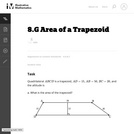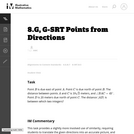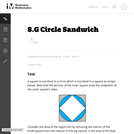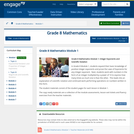
This task requires students to apply the Pythagorean Theorem.
- Subject:
- Mathematics
- Geometry
- Material Type:
- Activity/Lab
- Provider:
- Illustrative Mathematics
- Provider Set:
- Illustrative Mathematics
- Author:
- Illustrative Mathematics
- Date Added:
- 05/01/2012

This task requires students to apply the Pythagorean Theorem.

Khan Aacdemy provides free resources for teachers and students in various subjects. In the subject of Math, you can videos; tutorials, and practice for your students.

This paper makes recommendations for developing mathematics instruction for English Language Learners (ELLs) aligned with the Common Core State Standards. The recommendations can guide teachers, curriculum developers, and teacher educators as they develop their own ways of supporting mathematical reasoning and sense-making for ELLs.Some instructional recommendations discussed in the paper include: Focus on ELL students' mathematical reasoning, not the correctness of their mathematical language use. Shift to a focus on mathematical discourse practices; move away from simplified views of language. Support ELL students as they engage in complex mathematical language. Use ELL students' language and experiences as resources. Provide professional development to enhance teachers' awareness of ways to support ELs as they develop both language and mathematical knowledge.

This lesson unit is intended to help you assess how well students are able to use geometric properties to solve problems. In particular, it will support you in identifying and helping students who have the following difficulties: Solving problems relating to using the measures of the interior angles of polygons; and solving problems relating to using the measures of the exterior angles of polygons.

In this effort from YouCubed at the Stanford Graduate School of Education, the Indigenous Mathematics Educators Group shares new teaching resources for Indigenous art that is beautifully mathematical. Having students notice and wonder about this art can help them learn about mathematics, art, and Indigenous cultures. Resources include Indigenous mathematical art and lessons with questions to guide mathematical discussions.

Mathematically Productive Instructional Routines (MPIR) are short (10ish minutes), daily exercises aimed at building number sense. These six different MPIR are part of the Mathematically Productive Instructional Routines collection from the Washington Office of Public Instruction and the Washington Association of Educational Service Districts.

This task asks students to identify which of the six polygons have the same area. Students may complete the task using a variety of techniques including decomposing shapes, using transformations (rotations, reflections, translations) to move one or more parts of the figure to another part to more easily calculate the area, enclosing the polygon inside a larger rectangle and then subtract the areas of the "extra" pieces, etc.

This is three examples of "Type III" documents that I have prepared for students to write about math. Our school uses the Collins system of writing, but these could be adapted to a variety of classroom settings. The topics could be middle school or early high school topics, and they are set up to allow students to indepedently express their knowledge of the given topics in short essay form.
In addition to the writing prompts, I have included a rubric that students use to peer-edit each others' rough drafts. Students then use this feedback form to make the necessary corrections and submit a subsequent final draft.

Download GeoGebra Illustrative Mathematics LMS course files. All of GeoGebra's Illustrative Mathematics apps have been placed via links into Moodle courses - each unit is one course. There are twenty save middles school courses and more for high school (the list is growing.) These course files can then be uploaded into Moodle, Schoology, Canvas or D2L.

This is a text that covers the standard topics in a sophomore-level course in discrete mathematics: logic, sets, proof techniques, basic number theory, functions, relations, and elementary combinatorics, with an emphasis on motivation. It explains and clarifies the unwritten conventions in mathematics, and guides the students through a detailed discussion on how a proof is revised from its draft to a final polished form. Hands-on exercises help students understand a concept soon after learning it. The text adopts a spiral approach: many topics are revisited multiple times, sometimes from a different perspective or at a higher level of complexity. The goal is to slowly develop students’ problem-solving and writing skills.

Lesson OverviewStudents apply the multiplication property of equality to solve equations.Key ConceptsIn the previous lesson, students solved equations of the form x + p = q using the addition property of equality. In this lesson, they will solve equations of the form px = q using the multiplication property of equality. They will multiply or divide both sides of an equation by the same number to obtain an equivalent equation.Since multiplication by a is equivalent to division by 1a, students will see that they may also divide both sides of the equation by the same number to get an equivalent equation. Students will also apply this property to solving a particular kind of equation, a proportion.Goals and Learning ObjectivesUse the multiplication property of equality to keep an equation balanced.Use the multiplication property of equality to solve equations of the form px = q for cases in which p, q, and x are all non-negative rational numbers.Use the multiplication property of equality to solve proportions.

Students review the ways classroom habits and routines can strengthen their mathematical character. Students learn what a Gallery is and how to choose a Gallery problem to work on. They then choose one of three Gallery problems that introduce the unit’s technology resources. The three Gallery problems combine working with expressions with the resources available with this unit.Key ConceptsUnderstand that a Gallery gives students a choice of several problems. Understand what to consider when choosing a problem. Know how to work on a Gallery problem and how to present work on gallery problems.Goals and Learning ObjectivesKnow how to choose a problem from a Gallery.

This 25-day module begins the year by building on students fluency with addition and knowledge of arrays.
Find the rest of the EngageNY Mathematics resources at https://archive.org/details/engageny-mathematics.

Students discover the formula for finding the volume of a pyramid and apply the formula to solve problems.Key ConceptsThe volume of a pyramid is one-third the volume of a prism with the same base and height. The shape of the base does not matter (including if it’s a circle), and students will see the same one-third comparison between a cylinder and cone.GoalsUnderstand the formula for the volume of a pyramid.Apply the volume formula to solve problems.

A statistics lesson on describing and making claims from data representations, specifically linearly increasing data. Applies ideas of rate-of-change to develop writing a linear equation to fit the data, using the equation to interpolate and extrapolate additional information, and integrating the mathematical interpretation appropriately into a social sciences argument.

Adult education classrooms are commonly comprised of learners who have widely disparate levels of mathematical problem-solving skills. This is true regardless of what level a student may be assessed at when entering an adult education program or what level class they are placed in. Providing students with differentiated instruction in the form of Push and Support cards is one way to level this imbalance, keeping all students engaged in one high-cognitive task that supports and encourages learners who are stuck, while at the same time, providing extensions for students who move through the initial phase of the task quickly. Thus, all
students are continually moving forward during the activity, and when the task ends, all students have made progress in their journey towards developing conceptual understanding of mathematical ideas along with a productive disposition, belief in one’s own ability to successfully engage with mathematics.

The purpose of this task is to provide students an opportunity to use mathematics addressed in different standards in the same problem.

In this unit, students will read and interpret primary sources to address the question “How do we measure the attainment of human rights?” By exploring the Universal Declaration of Human Rights, the UN’s Guide to Indicators of Human Rights, and data about development indicators from multiple databases, students will unpack the complexities of using indicators to measure human rights.

This is a task from the Illustrative Mathematics website that is one part of a complete illustration of the standard to which it is aligned. Each task has at least one solution and some commentary that addresses important aspects of the task and its potential use.

This is a task from the Illustrative Mathematics website that is one part of a complete illustration of the standard to which it is aligned. Each task has at least one solution and some commentary that addresses important asects of the task and its potential use. Here are the first few lines of the commentary for this task: The vertices of eight polygons are given below. For each polygon: * Plot the points in the coordinate plane connect the points in the order that they a...

This is a task from the Illustrative Mathematics website that is one part of a complete illustration of the standard to which it is aligned. Each task has at least one solution and some commentary that addresses important aspects of the task and its potential use.

This is a task from the Illustrative Mathematics website that is one part of a complete illustration of the standard to which it is aligned. Each task has at least one solution and some commentary that addresses important asects of the task and its potential use. Here are the first few lines of the commentary for this task: Quadrilateral $ABCD$ is a trapezoid, $AD = 15$, $AB = 50$, $BC = 20$, and the altitude is 12. What is the area of the trapezoid?...

This is a task from the Illustrative Mathematics website that is one part of a complete illustration of the standard to which it is aligned. Each task has at least one solution and some commentary that addresses important asects of the task and its potential use. Here are the first few lines of the commentary for this task: A spider walks on the outside of a box from point A to B to C to D and finally to point E as shown in the picture below. Draw a net of the box and map ...

This is a task from the Illustrative Mathematics website that is one part of a complete illustration of the standard to which it is aligned. Each task has at least one solution and some commentary that addresses important aspects of the task and its potential use.

This is a task from the Illustrative Mathematics website that is one part of a complete illustration of the standard to which it is aligned. Each task has at least one solution and some commentary that addresses important asects of the task and its potential use. Here are the first few lines of the commentary for this task: Let $A$ be the area of a triangle with sides of length 25, 25, and 30. Let $B$ be the area of a triangle with sides of length 25, 25, and 40. Find $A/B...

This is a task from the Illustrative Mathematics website that is one part of a complete illustration of the standard to which it is aligned. Each task has at least one solution and some commentary that addresses important asects of the task and its potential use. Here are the first few lines of the commentary for this task: Cari is the lead architect for the city’s new aquarium. All of the tanks in the aquarium will be rectangular prisms where the side lengths are whole nu...

This is a task from the Illustrative Mathematics website that is one part of a complete illustration of the standard to which it is aligned. Each task has at least one solution and some commentary that addresses important asects of the task and its potential use. Here are the first few lines of the commentary for this task: During the 2005 Divisional Playoff game between The Denver Broncos and The New England Patriots, Bronco player Champ Bailey intercepted Tom Brady aroun...

This is a task from the Illustrative Mathematics website that is one part of a complete illustration of the standard to which it is aligned. Each task has at least one solution and some commentary that addresses important asects of the task and its potential use. Here are the first few lines of the commentary for this task: Anna enjoys dinner at a restaurant in Washington, D.C., where the sales tax on meals is 10%. She leaves a 15% tip on the price of her meal before the s...

This is a task from the Illustrative Mathematics website that is one part of a complete illustration of the standard to which it is aligned. Each task has at least one solution and some commentary that addresses important asects of the task and its potential use. Here are the first few lines of the commentary for this task: Take a square with area 1. Divide it into 9 equal-sized squares. Remove the middle one. What is the area of the figure now? Take the remaining 8 square...

This is a task from the Illustrative Mathematics website that is one part of a complete illustration of the standard to which it is aligned. Each task has at least one solution and some commentary that addresses important asects of the task and its potential use. Here are the first few lines of the commentary for this task: Point $B$ is due east of point $A$. Point $C$ is due north of point $B$. The distance between points $A$ and $C$ is $10\sqrt 2$ meters, and $\angle BAC...

This is a task from the Illustrative Mathematics website that is one part of a complete illustration of the standard to which it is aligned. Each task has at least one solution and some commentary that addresses important asects of the task and its potential use. Here are the first few lines of the commentary for this task: At the beginning of the month, Evan had \$24 in his account at the school bookstore. Use a variable to represent the unknown quantity in each transacti...

This is a task from the Illustrative Mathematics website that is one part of a complete illustration of the standard to which it is aligned. Each task has at least one solution and some commentary that addresses important asects of the task and its potential use. Here are the first few lines of the commentary for this task: A square is inscribed in a circle which is inscribed in a square as shown below. Note that the vertices of the inner square meet the midpoints of the o...

Students will resume their project and decide on dimensions for their buildings. They will use scale to calculate the dimensions and areas of their model buildings when full size. Students will also complete a Self Check in preparation for the Putting It Together lesson.Key ConceptsThe first part of the project is essentially a review of the unit so far. Students will find the area of a composite figure—either a polygon that can be broken down into known areas, or a regular polygon. Students will also draw the figure using scale and find actual lengths and areas.GoalsRedraw a scale drawing at a different scale.Find measurements using a scale drawing.Find the area of a composite figure.SWD: Consider what supplementary materials may benefit and support students with disabilities as they work on this project:Vocabulary resource(s) that students can reference as they work:List of formulas, with visual supports if appropriateClass summaries or lesson artifacts that help students to recall and apply newly introduced skillsChecklists of expectations and steps required to promote self-monitoring and engagementModels and examplesStudents with disabilities may take longer to develop a solid understanding of newly introduced skills and concepts. They may continue to require direct instruction and guided practice with the skills and concepts relating to finding area and creating and interpreting scale drawings. Check in with students to assess their understanding of newly introduced concepts and plan review and reinforcement of skills as needed.ELL: As academic vocabulary is reviewed, be sure to repeat it and allow students to repeat after you as needed. Consider writing the words as they are being reviewed. Allow enough time for ELLs to check their dictionaries if they wish.

This is a task from the Illustrative Mathematics website that is one part of a complete illustration of the standard to which it is aligned. Each task has at least one solution and some commentary that addresses important asects of the task and its potential use. Here are the first few lines of the commentary for this task: The taxi fare in Gotham City is \$2.40 for the first $\frac{1}{2}$ mile and additional mileage charged at the rate \$0.20 for each additional 0.1 mile....

This is a task from the Illustrative Mathematics website that is one part of a complete illustration of the standard to which it is aligned. Each task has at least one solution and some commentary that addresses important asects of the task and its potential use. Here are the first few lines of the commentary for this task: Below is a table showing the number of hits and the number of times at bat for two Major League Baseball players during two different seasons: SeasonDe...

In Grade 8 Module 1, students expand their basic knowledge of positive integer exponents and prove the Laws of Exponents for any integer exponent. Next, students work with numbers in the form of an integer multiplied by a power of 10 to express how many times as much one is than the other. This leads into an explanation of scientific notation and continued work performing operations on numbers written in this form.
Find the rest of the EngageNY Mathematics resources at https://archive.org/details/engageny-mathematics.

This is a task from the Illustrative Mathematics website that is one part of a complete illustration of the standard to which it is aligned. Each task has at least one solution and some commentary that addresses important asects of the task and its potential use. Here are the first few lines of the commentary for this task: The students in Mr. Rivera's art class are designing a stained-glass window to hang in the school entryway. The window will be 2 feet tall and 5 feet w...

Measuring the dimensions of nano-circuits requires an expensive, high-resolution microscope with integrated video camera and a computer with sophisticated imaging software, but in this activity, students measure nano-circuits using a typical classroom computer and (the free-to-download) GeoGebra geometry software. Inserting (provided) circuit pictures from a high-resolution microscope as backgrounds in GeoGebra's graphing window, students use the application's tools to measure lengths and widths of circuit elements. To simplify the conversion from the on-screen units to the real circuits' units and the manipulation of the pictures, a GeoGebra measuring interface is provided. Students export their data from GeoGebra to Microsoft® Excel® for graphing and analysis. They test the statistical significance of the difference in circuit dimensions, as well as obtain a correlation between average changes in original vs. printed circuits' widths. This activity and its associated lesson are suitable for use during the last six weeks of the AP Statistics course; see the topics and timing note below for details.

This purpose of this task is to help students see two different ways to look at percentages both as a decrease and an increase of an original amount. In addition, students have to turn a verbal description of several operations into mathematical symbols.

This task is primarily about volume and surface area, although it also gives students an early look at converting between measurements in scale models and the real objects they correspond to.